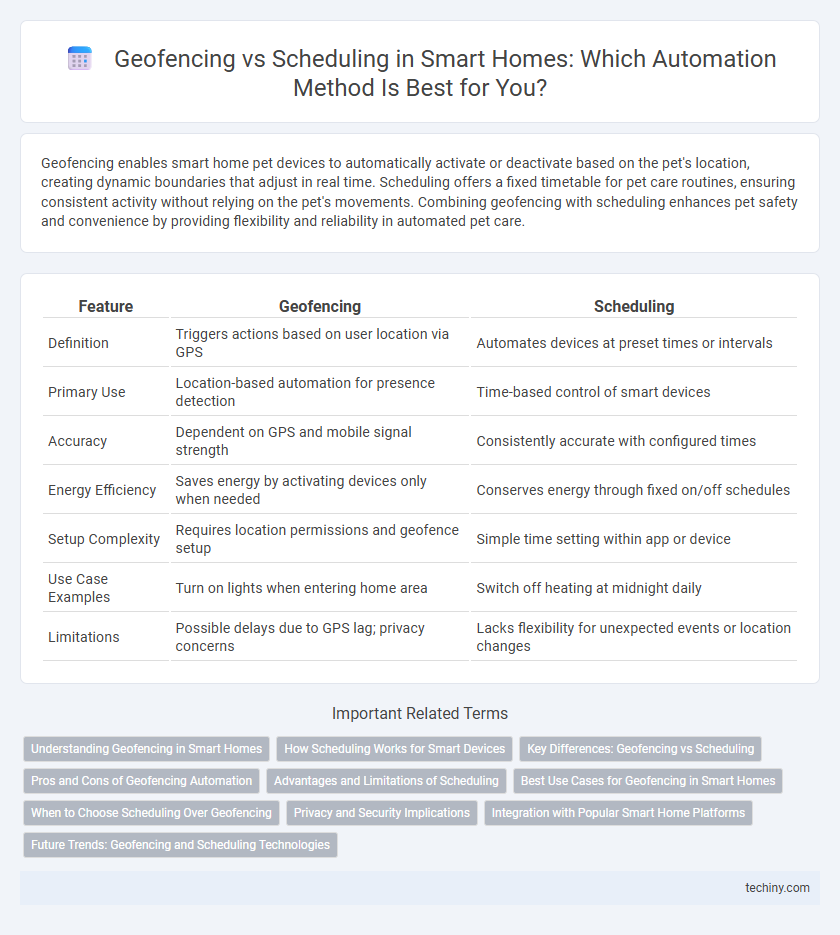Geofencing enables smart home pet devices to automatically activate or deactivate based on the pet's location, creating dynamic boundaries that adjust in real time. Scheduling offers a fixed timetable for pet care routines, ensuring consistent activity without relying on the pet's movements. Combining geofencing with scheduling enhances pet safety and convenience by providing flexibility and reliability in automated pet care.
Table of Comparison
| Feature | Geofencing | Scheduling |
|---|---|---|
| Definition | Triggers actions based on user location via GPS | Automates devices at preset times or intervals |
| Primary Use | Location-based automation for presence detection | Time-based control of smart devices |
| Accuracy | Dependent on GPS and mobile signal strength | Consistently accurate with configured times |
| Energy Efficiency | Saves energy by activating devices only when needed | Conserves energy through fixed on/off schedules |
| Setup Complexity | Requires location permissions and geofence setup | Simple time setting within app or device |
| Use Case Examples | Turn on lights when entering home area | Switch off heating at midnight daily |
| Limitations | Possible delays due to GPS lag; privacy concerns | Lacks flexibility for unexpected events or location changes |
Understanding Geofencing in Smart Homes
Geofencing in smart homes uses GPS or RFID technology to create virtual boundaries that trigger automated actions when a homeowner enters or leaves a predefined area, enhancing security and energy efficiency. This location-based automation contrasts with scheduling, which relies on preset times rather than real-time user presence, making geofencing more adaptive to daily routines. Integration with smartphones and smart devices allows geofencing to dynamically control lighting, heating, and security systems based on actual occupancy patterns.
How Scheduling Works for Smart Devices
Scheduling for smart devices operates by programming specific times for devices to turn on or off automatically, enhancing convenience and energy efficiency. Users set predefined timers or routines via a smart home app, enabling consistent control without manual intervention. This method contrasts with geofencing, which relies on the location of the user's smartphone to trigger device actions based on proximity.
Key Differences: Geofencing vs Scheduling
Geofencing uses GPS or Bluetooth technology to trigger smart home actions based on a user's location, enabling automation like adjusting thermostat settings when arriving or leaving home. Scheduling relies on predefined time-based triggers, such as turning lights on at sunset or activating security systems at night. The key difference lies in geofencing's dynamic, location-driven automation versus scheduling's fixed, time-driven control.
Pros and Cons of Geofencing Automation
Geofencing automation offers precise control by triggering smart home devices based on the homeowner's real-time location, enhancing convenience and energy efficiency. It requires a stable GPS signal and may raise privacy concerns due to constant location tracking, with potential issues in multi-resident homes causing unintended activations. Unlike scheduling, geofencing adapts dynamically to user presence but depends heavily on smartphone battery life and signal accuracy, limiting its reliability in certain environments.
Advantages and Limitations of Scheduling
Scheduling in smart homes offers precise control by automating device operations based on set times, enhancing energy efficiency and convenience without constant user input. Its limitations include inflexibility to unexpected changes in routines or weather conditions, potentially causing inefficiencies or missed automation opportunities. Unlike geofencing, scheduling lacks real-time adaptability, making it less responsive to dynamic user locations and preferences.
Best Use Cases for Geofencing in Smart Homes
Geofencing in smart homes excels at automating security and energy management by triggering actions based on residents' real-time location, such as arming alarms or adjusting thermostats when occupants leave or arrive. Unlike fixed scheduling, geofencing adapts dynamically to unpredictable routines, ensuring personalized convenience and enhanced energy efficiency. Ideal use cases include enabling hands-free lighting control upon entry and optimizing HVAC settings according to precise presence detection, which maximizes both comfort and cost savings.
When to Choose Scheduling Over Geofencing
Scheduling is ideal for smart home automation when occupants have consistent daily routines, ensuring devices activate or deactivate at precise times without relying on location data. Unlike geofencing, which depends on GPS signals and may experience delays or inaccuracies, scheduling guarantees predictable control for lighting, heating, and security systems. Choose scheduling for energy savings and convenience during fixed work hours, sleep cycles, or recurring household activities.
Privacy and Security Implications
Geofencing uses real-time location tracking to automate smart home functions, raising concerns about continuous data collection and potential breaches of personal privacy. Scheduling relies on predefined times for automation, minimizing the need for sensitive location data and reducing exposure to location tracking risks. Prioritizing encryption and secure data management protocols is essential in both approaches to safeguard user data and prevent unauthorized access.
Integration with Popular Smart Home Platforms
Geofencing integrates seamlessly with popular smart home platforms like Apple HomeKit, Google Assistant, and Amazon Alexa by using location data to automate home settings based on user proximity, enhancing convenience and energy efficiency. Scheduling features in these platforms allow users to set precise, recurring automation routines, ensuring consistent control over devices without requiring real-time location tracking. Both geofencing and scheduling are compatible with major ecosystems, enabling flexible automation strategies tailored to individual lifestyle preferences and improving overall smart home management.
Future Trends: Geofencing and Scheduling Technologies
Geofencing and scheduling technologies in smart homes are evolving through integration with artificial intelligence and machine learning, enabling more adaptive and personalized automation based on user habits and environmental factors. The future trend points toward hybrid systems combining geolocation data with predictive scheduling algorithms to optimize energy efficiency and security. Enhanced interoperability between devices and improved data privacy measures will drive wider adoption of these intelligent, context-aware smart home solutions.
Geofencing vs Scheduling Infographic

 techiny.com
techiny.com